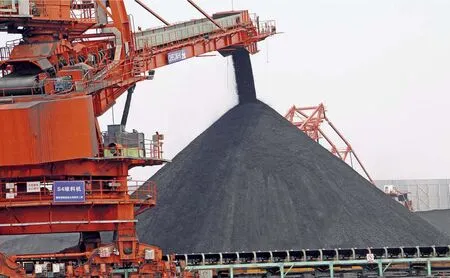When the Lights Go Out
2011-10-14ByLANXINZHEN
By LAN XINZHEN
When the Lights Go Out
By LAN XINZHEN
China takes preemptive steps as it gears up to face the most severe power shortage in its history this summer

FU XINChUN
With the country entering the power consumption peak months, Chinese power companies are concerned about their ability to keep the nation powered.
According to Tan Rongyao, supervisor of the State Electricity Regulatory Commission, the electricity shortfall will hit 30 million kw, even higher than 2004 when China suffered the worst power shortage since the early 1990s. At that time, power cuts or limits were imposed in 27 provinces, municipalities and autonomous regions.
If the shortage of coal and insufficient hydraulic power generation continue, the power shortfall will peak 40 million kw, said Shuai Junqing, Vice President of the State Grid Corp. of China (SGCC), the country’s leading power distributor.
In the past five years, China’s total installed power capacity increased 445 million kw, but power shortages and blackouts have yet to be completely eliminated.
The last straw
Li Huiyong, a chief macroeconomic analyst for Shenyin & Wanguo Securities, said many factors contribute to China’s power shortages.
“Around the year 2000, limited investments in the electric power industry led to the antiquation of the country’s power generating facilities, which eventually triggered another round of power shortage in 2004,” Li said.“China’s power generation relies heavily on coal. Therefore, coal price increases erode electricity generation. From 2007 to 2008, coal price soared 300 percent, which caused a 15-percent hike in electric power price and directly triggered the electricity shortage in 2008.”
As for the unprecedented power shortage this summer, Shuai blamed the electricity consumption boosted by the expansion of high energy-consumption and outdated industries. Figures of the National Bureau of Statistics show that in Zhejiang, the heavy industrial added value increased 13.7 percent year on year in the first quarter this year, while the electricity consumption of high energy-consuming sectors such as chemical and non-ferrous metal industries soared 20 percent year on year.
Shuai also claimed that the regional imbalance between the supply and demand of power has contributed to the power shortage. Economically developed coastal areas lack coal and power plants, but economically underdeveloped western and northern regions boast both. The weak trans-regional power transmission grid created a bottleneck in power transmission from northeast and northwest China to eastern and central parts of the country, said Shuai.
A survey conducted by Beijing-based dailyEconomic Informationshowed that the regional grid in the Inner Mongolia Autonomous Region had a surplus of 6.4 million kw in April. According to Lu Jian, Deputy Director of the Department of Development and Planning of SGCC, the northeast and northwest grids will have a surplus of 13 million kw and 14 million kw, respectively, this summer.
The problem lies in getting northwest and northeast China’s power surplus to powerhungry central and east China, said Shuai.
Solutions
The battle against one of the most severe power shortages in China’s history has seen central and local government bodies employ a variety of tactics. To boost power supplies, the National Development and Reform Commission (NDRC), China’s top economic regulator, increased power prices for industrial users in 15 provinces, effective June 1. Residential power prices will remain unchanged.
In response to the hovering power shortfall, another feasible method may be investment in grid construction. SGCC plans to invest 1.7 trillion yuan ($254 billion) in power grid construction during the 12th Five Year Plan period (2011-15) to increase the total installed power capacity by 500 million kw to 1.43 billion kw during the next five years.
SGCC will also enhance the construction of trans-regional power transmission channels to alleviate power shortages, said Shuai. The current trans-regional power transmission capacity of the SGCC is 31.67 million kw.
In addition, ultra-high voltage (UHV) transmission lines have become a possible remedy to ease power shortages. According to Shuai, SGCC is building a Yunnan Jinping-Jiangsu UHV transmission line to send hydropower from Sichuan and Yunnan provinces in west China to Jiangsu, Zhejiang and Shanghai in the east.
“This line will be the world’s longest UHV direct current with a transmission capacity of 7.2 million kw,” said Shuai. The project is expected to be completed by 2013.
According to Shuai, more UHV lines are planned to boost the country’s trans-regional power supply capacity. Differentiated power prices will be imposed on high energy-consuming industries to curtail excessive energy consumption.
To prevent the damage on power transmission caused by dramatic increases in electro-load, SGCC has enhanced the security assessment and operation maintenance of its grid facilities, said Shuai.
Since coal power accounts for 75 percent of China’s total installed power capacity and 82 percent of the country’s generating capacity, coal prices are vital to power companies.
“The key issue to solving the power shortfall this summer is to stabilize the price of thermal coal and guarantee coal supplies,” said Shuai.
While industrial use may face power cuts, priority of power supply will be given to residents, hospitals, schools and other institutes of public interest and national security.
“In the long term, a viable way to quench the thirst for power is to accelerate the transformation of the power development mode and increase energy utilization effciency,” Shuai said.
Coal price counts
China’s heavy reliance on coal has caused prices of the natural resource to jump several fold this year. For power plants, this is a double burden since electricity prices are regulated by the Central Government while coal prices are market oriented.
Even though electricity prices for industrial use have been increased, the slight price change has done little for power companies to make up for rising coal prices.
In the first four months this year, China’s fve largest power groups reported a combined loss of 10.57 billion yuan ($1.63 billion), up 3.22 times of the loss during the same period of last year, according to China Electricity Council data.
Yu Yanshan, Deputy Director of the Office of the State Electricity Regulatory Commission, also pointed out that the high cost of generating power has forced power companies to avoid operating at full capacity, highlighting the problem of regulated power prices lagging behind the market reality.
An imbalance between supply and demand is the apparent cause of recent power shortage, and the long-standing inconsistency in coal and electricity prices has triggered the power shortfall, said Li Ting, an analyst at the Distribution Productivity Promotion Center of China Commerce, a government-backed research institute.
The current electricity price is not realistic in an age of skyrocketing costs for coal, and power shortage, said Zhou Dadi, Deputy Director of China Energy Research Society.
“It’s time to optimize the mechanism so that it can synthesize the primary energy price and sales price,” Zhou said.
Regarding the call to set power prices free, Bai Jianhua, assistant chief economist of the State Grid Energy Research Institute, was rather conservative.
“The price of electricity is closely linked to people’s livelihoods and its adjustment should be done carefully. Allowing power prices to change in accordance with coal prices is not in line with China’s situation,” said Bai.
